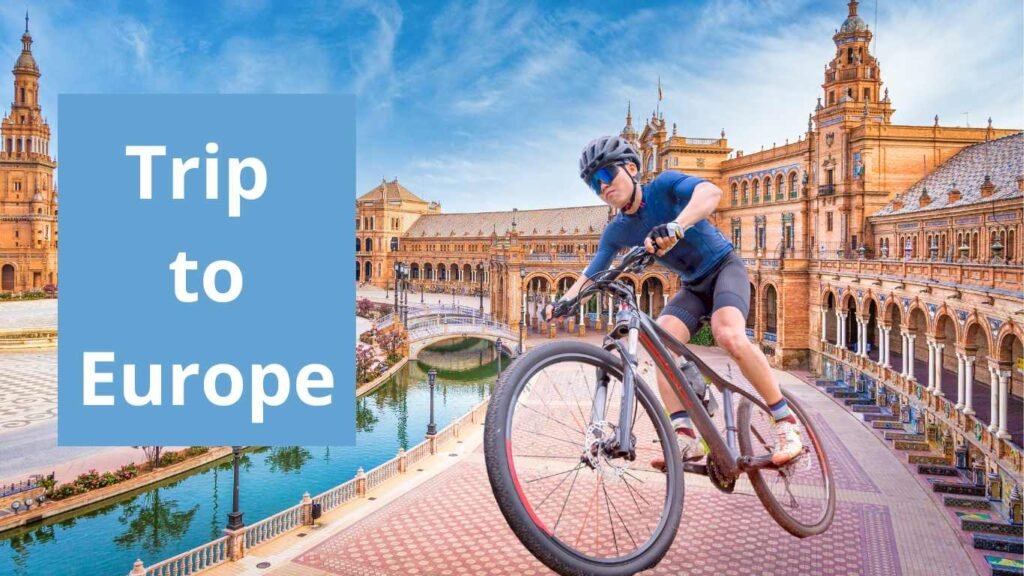Planning a mountain bike trip to a whole new continent or country seems hard. But it is easy; you just need to know how to transport your mountain biking gear.
You need to understand what to expect from the trials, what type of trial you should visit, like the Alps, and a few more things.
If you know all these things, then you can enjoy the European mountain bike trip.
So, in this article, we’ll discuss everything that you need to know, such as where to ride, choosing the region for best trials, planning your gear setup, packing tips, renting a bike etc, understanding logistics, and many more things.
Decide Where to Ride

Europe is big, and there are many types of trials that will blow your mind. For example, the Alps is one of the famous trials that come up in many riders’ minds when they plan a European bike trip.
Besides this, some places like Chamonix in France or the Italian Dolomites are also legendary downhill trails that you may want to visit.
But there are also many lesser-known gems such as Slovenia’s Soca Valley and Spain’s Pyrenees, plus they are cheaper and quieter too and have stunning views.
So, your first task is to decide what type of riding you want to do. For example, are you a downhill rider, or do you prefer cross-country rides to enjoy beautiful scenery?
If you are into downhill, you can visit spots like Morzine in France or Salabaug in Austria. They have a lift system so you can get to the top very quickly without any hard work.
If you are an XC or cross-country lover, then Georgia’s trail Trans Caucasus is for you.
Besides this, Portugal’s Douro Valley is also a good place. There, you can find too many tourists engaging with these places’ cultures.
Also read: Most Scenic Mountain biking trails in the world you can add in your bucket list
How to Choose a Region:
Before choosing the region, you need to know your skill level, your budget, and the weather conditions that you prefer. Based on that, you can decide on a region.
Weather: Southern European countries like Spain, Italy, and Portugal are best for riding outside during the summer season. You can visit trails like the Alps or Scandinavia in June-September if you want to hit snow.
Skill Level: You can visit places like France’s Les Gets, Andorra, etc. These types of places are suitable for every type of rider, from beginner to advanced. However, I still recommend you research specific trials before riding.
Budget: Countries like Switzerland are expensive, but you have alternatives like Bulgaria or Romania. They have epic riding but at half the cost of Switzerland.
Pro Tip: You can use apps like Trailforks or Komoot to find the best trials depending on your difficulty level and the region you want to ride.
Plan Your Gear Setup

You can rent a mountain bike when you reach the destination where you want to ride, such as France, Italy, Portugal, etc.
On the other hand, you have a different option. You can bring your own bike to the destination, but it is not really a straightforward process.
However, there are airlines that allow you to bring your own mountain bike. For example, you can use an Evoc bag.
Besides this, you want to call your airline to confirm that you want to transport the bike. So they will tell you the policies.
Plus, airlines require advance booking, so you have to pay around $50 to $200.
When packing a mountain bike:
You need to remove pedals, handlebars, and wheels. Then, wrap them in a bubble wrap. Besides this, deflate your tires slightly to avoid pressure during the flight.
Don’t forget to have spare tools and your mountain biking helmet in the bag’s side pocket.
You see, it’s a little time-consuming and not a straightforward process. That’s why you can rent a bike. In my opinion, it is better than carrying your own bike to a different continent or country.
Also read: How to fly with your mountain bike in an Airplane
Renting a Bike
If you don’t want to fly with your mountain bike, then renting is the best choice.
Most big mountain bike destinations have a rental shop, such as in Livigno, Italy. You can rent a full-suspension bike for around 60 Euros per day.
The price can fluctuate depending on when you are visiting. However, when renting a mountain bike, you will get a helmet with the bike and some protective gear.
Furthermore, you want to check reviews of the rental shop where you are renting a mountain bike.
Plus, there are some mountain biking essential gear that you can carry, such as a multi-tool kit, portable tire pump, snacks, energy bars, etc. And a hydration pack. You can’t forget it, especially in high-altitude areas.
Understand the Logistics
Carrying logistics is a little bit tricky. However, if you know these things, it’s easy.
Europe has one of the best train systems. It’s fantastic, but they do not allow you to carry a mountain bike.
So, in that case, if you are carrying your own bike to a different country, then you can rent a car to carry your bike.
Especially if you plan to visit multiple trial heads, you should rent a vehicle like a wagon or a small van to carry your bike and gear. And it’s good if you avoid booking a tiny hatchback.
Besides this, you want to check if the rental company has included roof or rear bike racks. Remember you may have to pay some extra money.
As I said before most trains in Europe do not allow you to carry a mountain bike. However, some rail networks, like in Switzerland, are friendly with bikes.
You may find a dedicated bike space, even special bike passes. In contrast, Italy’s regional trains do not have bike-carrying options.
Pro tip: you can do a little bit of research before boarding. You can also use apps and websites like Rome2Rio to figure out transit options in each country.
Accommodations for Bikers
When booking a hotel, make sure it is labeled as bike-friendly because these types of hotels and locations often include perks like secure bike storage, repair stations, trail maps, and even guides.
Besides the hotel, you can also choose a hostel, where the owner can share his or her own personal experience and tell you about some hidden gems and many more things.
Budget Breakdown:
- Hostels: €20-40/night
- Airbnb or Guesthouses: €50-100/night
- Bike Hotels: €100+ but worth it for the amenities.
If you are a camper, then there are many affordable campsites in Europe, especially in mountain regions, so you want to make sure camping is legal in the wild.
In Europe, everywhere, there are different rules. For example, you can go camping in Sweden, but not in France, in most mountain regions.
Know the Rules and Trail Etiquette

There are many trials in the US, Europe, and many countries, and all trials have different rules. So, you must make sure to stick to their rules and ensure you keep enjoying this mountain biking sport.
For example, in Switzerland, hiking trials are often shared with bikers, which means yielding to hikers is non-negotiable.
On the other hand, in Austria, many trials are closed during certain seasons because of wildlife prevention efforts.
Trail Markings to Look For:
- Blue/Green: Beginner-friendly routes
- Red: Intermediate (some tech sections)
- Black: Expert trails (be ready for steep descents and drops!)
You can check local maps or signage, and don’t assume that all trials are open to bikers because some areas are strictly for enforced trial bans for mountain bikes.
And if you are using Airbnb or a hostel for a stay, then you can talk to the owner or some local people about the trail, locality, or anything else you want.
Prepare for the Unexpected
You are visiting another country or a continent. That’s why you must carry some important things in case of an emergency.
Sometimes, you may slip and slide on trails, which can be really ugly.
Must-Haves for Emergencies:
- A compact first-aid kit.
- Trail maps (download offline versions on your phone).
- Extra layers—European mountains are notorious for rapid temperature changes.
- Local emergency numbers (in most of Europe, it’s 112).
Final Thoughts
Planning a mountain biking trip to Europe is an awesome idea and very exciting, but you gotta do some research work before arriving in the country.
Such as deciding where you want to stay, where you want to ride, what place you want to visit, etc.
I suggest you pick a small region first. Another tip that I would suggest to you is not to carry your bike to a different country; instead of that, you can rent a bike. It’s a better choice.
However, You can just carry some essential things like snacks for energy, water bottles, air pumps, etc.
Where are the best places to mountain bike in Europe?
The best destination in Europe depends on your riding style and preference, such as downhill, cross-country, enduro, etc.
Some of the best places for mountain biking in Europe are the Alps in France, Switzerland, Italy, and Austria. They have epic trails and lift service available.
Scotland has both rugged terrain and natural trails. The Dolomites in Italy also have beautiful scenery.
Besides this, you can also visit Spain’s Canary Islands for year-round riding. And for flow trials, the Czech Republic is a good place.
When is the best time to go mountain biking in Europe?
The best mountain biking season in Europe depends on region and altitude.
The Alps and other mountainous regions are generally good in late spring, from May to June, and also in early autumn, like September and October.
Besides this, you can avoid snow and icy conditions in Europe.
There are some lower elevation areas as well, like the Tuscany region of Italy, and some parts of Spain offer expanded riding seasons, too.
If you don’t like the hot summer season, then it’s better to avoid southern Europe in August. Besides this, you can also check local trail conditions and weather forecasts before the trip.
What do I need to pack for a mountain biking trip to Europe?
First of all, you need to pack some essential gear for your mountain biking trip to Europe, such as a helmet, riding clothes, like you can have extra gloves, eye protection like goggles, sturdy shoes, etc.
Most importantly, you should carry some rental information.
Besides that, if you want to consider some specific tools for bike repair, such as a first aid kit or a hydration pack like a water bottle, navigation tools, GPS devices, and maps, you can also download Google Maps offline.
Moreover, you want to have travel documents, insurance information, and a European health insurance card, EHIC, which is important too.
Plus, what you need to pack also depends on the specific region. For example, if the region is cold, then you will need an extra layer, like a jacket, etc.
If the season is rainy, then you may need waterproof gear, jackets, etc., for wet conditions.
Also read: Mountain biking clothes for Men, Women & Kids

Ali is the founder of Mountain Bike Insider and an passionate rider with years of hands-on experience in mountain biking. From testing gear to exploring trails, Ali writes based on real riding knowledge to help others make smart, safe, and enjoyable biking choices. Every guide is built on research, personal use, and a passion for the sport.







